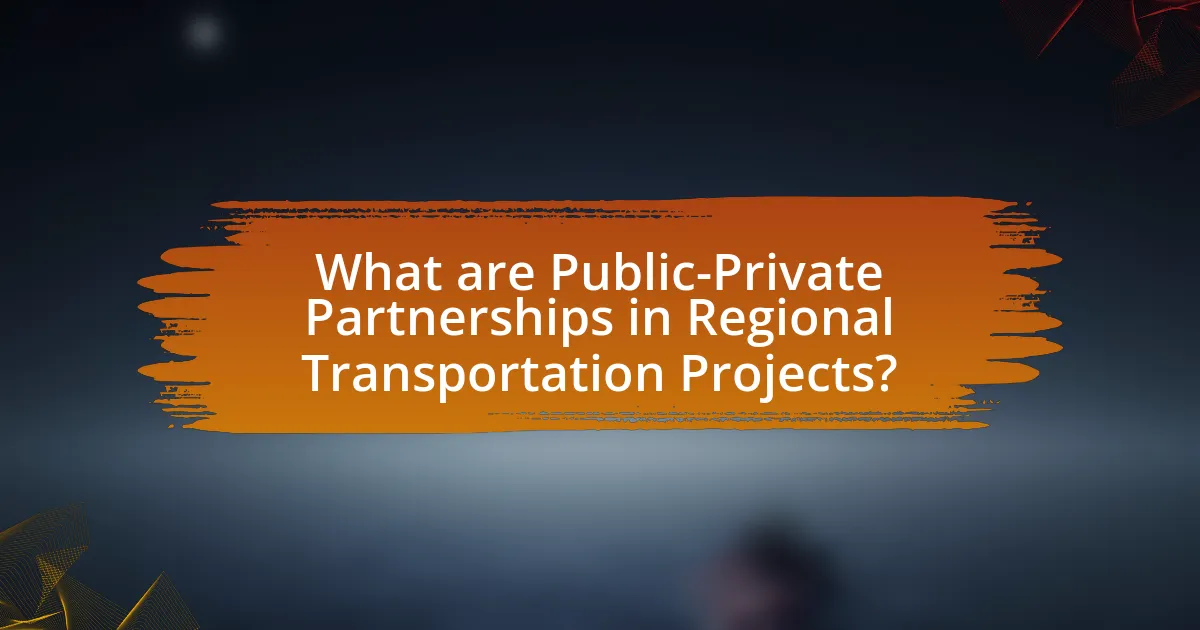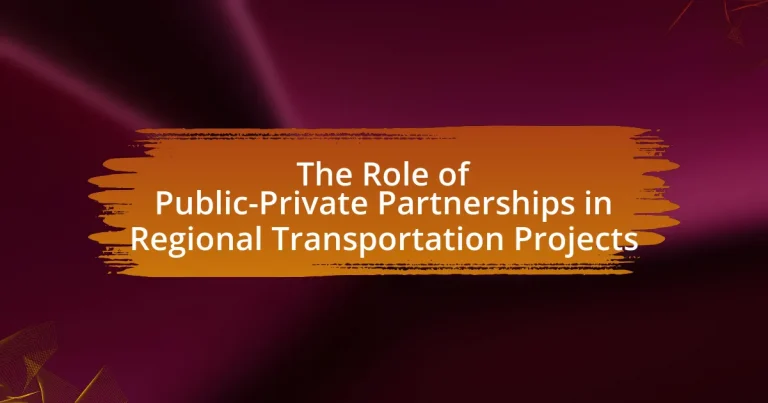Public-Private Partnerships (PPPs) in regional transportation projects are collaborative agreements between government entities and private sector companies aimed at financing, building, and operating transportation infrastructure. This article explores the functioning of PPPs, highlighting their key components, objectives, and the collaborative dynamics among stakeholders. It also addresses the challenges faced by these partnerships, including funding uncertainties and risk allocation, while discussing the impact of technology and sustainability on future projects. Additionally, the article identifies success factors and metrics for evaluating the effectiveness of PPPs, providing practical tips for enhancing these partnerships in transportation development.

What are Public-Private Partnerships in Regional Transportation Projects?
Public-Private Partnerships (PPPs) in regional transportation projects are collaborative agreements between government entities and private sector companies to finance, build, and operate transportation infrastructure. These partnerships leverage private investment and expertise to enhance public transportation systems, often resulting in improved efficiency and reduced costs for taxpayers. For example, the U.S. Department of Transportation reported that PPPs can accelerate project delivery and provide innovative solutions, as seen in successful projects like the I-495 Capital Beltway in Virginia, which utilized a PPP model to expand and improve the highway system.
How do Public-Private Partnerships function in the context of transportation?
Public-Private Partnerships (PPPs) in transportation function by combining public sector resources and private sector expertise to finance, build, and operate transportation infrastructure. In this model, the government typically provides regulatory oversight and may contribute funding, while private entities invest capital, manage construction, and operate the facilities, sharing the risks and rewards. For example, the U.S. Department of Transportation reported that PPPs have been instrumental in developing projects like toll roads and bridges, which leverage private investment to expedite construction and improve efficiency. This collaboration allows for innovative solutions and can lead to enhanced service delivery and reduced public expenditure on infrastructure projects.
What are the key components of a Public-Private Partnership?
The key components of a Public-Private Partnership (PPP) include shared risk, investment, and collaboration between public and private sectors. In a PPP, the public sector typically provides regulatory support and oversight, while the private sector contributes capital, expertise, and innovation. This collaboration aims to deliver public services or infrastructure projects more efficiently. For instance, the U.S. Department of Transportation highlights that PPPs can leverage private funding to enhance transportation infrastructure, thereby reducing the financial burden on taxpayers.
How do stakeholders collaborate within these partnerships?
Stakeholders collaborate within public-private partnerships in regional transportation projects through structured communication, shared objectives, and resource pooling. This collaboration often involves regular meetings, joint planning sessions, and the establishment of clear roles and responsibilities to ensure alignment on project goals. For instance, stakeholders may utilize collaborative platforms and tools to facilitate information sharing and decision-making processes, which enhances transparency and accountability. Evidence of effective collaboration can be seen in successful projects like the Denver FasTracks initiative, where public agencies and private firms worked together to deliver a comprehensive transit system, demonstrating the benefits of stakeholder engagement in achieving common objectives.
What are the primary objectives of Public-Private Partnerships in transportation?
The primary objectives of Public-Private Partnerships (PPPs) in transportation are to enhance infrastructure development, improve service efficiency, and share financial risks. These partnerships leverage private sector expertise and investment to deliver transportation projects more effectively than traditional public procurement methods. For instance, a study by the World Bank indicates that PPPs can reduce project costs by 20% and accelerate project delivery timelines, thereby improving overall service quality and accessibility in regional transportation systems.
How do these partnerships aim to improve infrastructure?
Public-private partnerships (PPPs) aim to improve infrastructure by leveraging the strengths of both sectors to enhance efficiency, funding, and innovation in regional transportation projects. These collaborations enable the public sector to access private capital and expertise, which can lead to faster project delivery and reduced costs. For instance, a study by the World Bank indicates that PPPs can reduce project costs by 20% to 30% compared to traditional public procurement methods. Additionally, PPPs often incorporate performance-based contracts that incentivize private partners to maintain high-quality standards throughout the project lifecycle, ensuring long-term sustainability and improved service delivery.
What role do they play in enhancing service delivery?
Public-Private Partnerships (PPPs) play a crucial role in enhancing service delivery by combining public sector oversight with private sector efficiency and innovation. This collaboration allows for improved infrastructure development, faster project completion, and better resource allocation, ultimately leading to enhanced transportation services. For instance, a study by the World Bank indicates that PPPs can reduce project costs by 20-30% and accelerate delivery timelines by up to 50%, demonstrating their effectiveness in optimizing service delivery in regional transportation projects.
What challenges do Public-Private Partnerships face in regional transportation projects?
Public-Private Partnerships (PPPs) in regional transportation projects face several significant challenges, including funding uncertainties, risk allocation, and regulatory complexities. Funding uncertainties arise from the reliance on both public and private sources, which can lead to inconsistencies in financial commitments and project viability. Risk allocation is another challenge, as determining which party bears specific risks can lead to disputes and affect project timelines. Regulatory complexities often hinder the efficiency of PPPs, as navigating various governmental approvals and compliance requirements can delay project implementation. These challenges are documented in studies such as the “Public-Private Partnerships in Transportation: A Review of the Literature” by the National Cooperative Highway Research Program, which highlights the importance of clear agreements and stakeholder engagement to mitigate these issues.
What are the common risks associated with these partnerships?
Common risks associated with public-private partnerships (PPPs) in regional transportation projects include financial risk, operational risk, and regulatory risk. Financial risk arises from potential cost overruns and revenue shortfalls, which can jeopardize the project’s viability. Operational risk involves challenges in project execution, such as delays or inefficiencies that can affect service delivery. Regulatory risk pertains to changes in laws or policies that may impact the partnership’s terms or project feasibility. These risks are documented in various studies, including the “Public-Private Partnerships: A Guide for Local Governments” by the National League of Cities, which highlights the importance of risk assessment in successful PPP implementations.
How can conflicts between public and private interests be managed?
Conflicts between public and private interests can be managed through effective stakeholder engagement and transparent communication. Engaging stakeholders from both sectors early in the project planning process fosters mutual understanding and collaboration, which can help identify potential conflicts before they escalate. For instance, the Federal Highway Administration emphasizes the importance of stakeholder involvement in public-private partnerships (PPPs) to align objectives and expectations, thereby reducing friction. Additionally, establishing clear contractual agreements that outline roles, responsibilities, and performance metrics can mitigate misunderstandings and ensure accountability. Research indicates that successful PPPs often incorporate mechanisms for conflict resolution, such as mediation or arbitration, which provide structured approaches to address disputes as they arise.
How do Public-Private Partnerships impact regional transportation development?
Public-Private Partnerships (PPPs) significantly enhance regional transportation development by leveraging private sector investment and expertise to improve infrastructure efficiency and service delivery. These collaborations often result in faster project completion times, as private entities can mobilize resources and innovate more rapidly than public agencies. For instance, the I-595 Corridor Improvements Project in Florida, a PPP initiative, was completed in just three years, significantly reducing congestion and improving travel times for commuters. Additionally, PPPs can alleviate public funding constraints by attracting private capital, which allows for the expansion and modernization of transportation networks without solely relying on taxpayer dollars. This model has been shown to increase overall project quality and sustainability, as private partners are incentivized to maintain high standards throughout the lifecycle of the project.
What are the success factors for effective Public-Private Partnerships?
The success factors for effective Public-Private Partnerships (PPPs) include clear communication, shared objectives, and strong governance structures. Clear communication ensures that all stakeholders understand their roles and responsibilities, which minimizes misunderstandings and fosters collaboration. Shared objectives align the interests of public and private entities, facilitating a common vision for project outcomes. Strong governance structures provide oversight and accountability, ensuring that both parties adhere to agreed-upon terms and performance metrics. Research indicates that projects with these success factors are more likely to meet their goals and deliver value, as evidenced by case studies in regional transportation projects where effective PPPs have led to improved infrastructure and service delivery.
How can best practices be identified and implemented?
Best practices can be identified and implemented through systematic evaluation and collaboration among stakeholders in public-private partnerships. This process involves conducting thorough research to analyze existing successful models, engaging in stakeholder consultations to gather insights, and utilizing performance metrics to assess effectiveness. For instance, the Federal Highway Administration emphasizes the importance of data-driven decision-making in identifying best practices, which can lead to improved project outcomes in regional transportation initiatives. By continuously monitoring and adapting strategies based on feedback and results, organizations can effectively implement these best practices to enhance project efficiency and stakeholder satisfaction.
What metrics are used to evaluate the success of these partnerships?
Metrics used to evaluate the success of public-private partnerships in regional transportation projects include cost savings, project completion time, service quality, and user satisfaction. Cost savings are assessed by comparing the actual costs of the project against the projected budget, often revealing efficiencies gained through private sector involvement. Project completion time is measured by the duration taken to finish the project relative to the planned timeline, indicating the effectiveness of collaboration. Service quality is evaluated through performance indicators such as reliability, safety, and maintenance standards, which reflect the operational success of the partnership. User satisfaction is gauged through surveys and feedback mechanisms, providing insights into the public’s perception of the transportation services provided. These metrics collectively offer a comprehensive view of the partnership’s effectiveness and impact on regional transportation.
What are the future trends in Public-Private Partnerships for transportation?
Future trends in Public-Private Partnerships (PPPs) for transportation include increased digitalization, sustainability initiatives, and innovative financing models. Digitalization is transforming how PPPs operate, with technologies like smart traffic management systems and data analytics enhancing efficiency and user experience. Sustainability is becoming a priority, as governments and private entities focus on environmentally friendly projects, such as electric public transport systems and green infrastructure. Innovative financing models, including revenue-sharing agreements and performance-based contracts, are emerging to attract private investment while ensuring public accountability. These trends are supported by the growing recognition of the need for resilient and adaptive transportation systems in response to urbanization and climate change challenges.
How is technology influencing these partnerships?
Technology is significantly influencing public-private partnerships in regional transportation projects by enhancing communication, data sharing, and project management efficiency. Advanced technologies such as cloud computing and real-time data analytics facilitate seamless collaboration between public entities and private firms, allowing for more informed decision-making and resource allocation. For instance, the use of Geographic Information Systems (GIS) enables stakeholders to visualize project impacts and optimize routes, leading to improved planning and execution. Additionally, the integration of smart transportation systems, which utilize IoT devices, enhances operational efficiency and safety, thereby increasing the overall effectiveness of these partnerships.
What role does sustainability play in future projects?
Sustainability is essential in future projects as it guides the development of environmentally responsible and economically viable solutions. In the context of public-private partnerships in regional transportation projects, sustainability ensures that infrastructure investments minimize ecological impact while promoting social equity and economic growth. For instance, integrating sustainable practices can lead to reduced greenhouse gas emissions, improved air quality, and enhanced community resilience. According to the Global Infrastructure Facility, sustainable infrastructure can save up to 30% in lifecycle costs, demonstrating the financial viability of incorporating sustainability into project planning and execution.
What practical tips can be applied to enhance Public-Private Partnerships in transportation?
To enhance Public-Private Partnerships (PPPs) in transportation, stakeholders should prioritize clear communication and shared objectives. Establishing transparent channels for dialogue between public entities and private partners fosters trust and aligns goals, which is crucial for project success. Additionally, implementing performance-based contracts can incentivize private partners to meet or exceed project benchmarks, ensuring accountability and efficiency. Research indicates that projects with well-defined roles and responsibilities experience a 20% increase in on-time delivery compared to those without such clarity. Furthermore, engaging local communities in the planning process can lead to better project acceptance and support, as evidenced by studies showing that community involvement reduces opposition by up to 30%.


